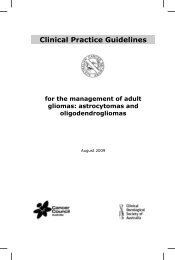Clinical Practice Guidelines for the management of locally advanced ...
Clinical Practice Guidelines for the management of locally advanced ...
Clinical Practice Guidelines for the management of locally advanced ...
Create successful ePaper yourself
Turn your PDF publications into a flip-book with our unique Google optimized e-Paper software.
9 SOCIO-ECONOMIC ASPECTS OF ADVANCED<br />
PROSTATE CANCER<br />
9.1 Introduction<br />
Adverse social and economic circumstances are well-recognised determinants <strong>of</strong> access to and use <strong>of</strong><br />
health care. Less affluent or socially disadvantaged people live shorter lives and suffer more illness<br />
than those who are well <strong>of</strong>f. 1 Guideline development needs to consider how issues such as income,<br />
education, occupation or employment, ethnicity, indigenous status, literacy, and place <strong>of</strong> residence<br />
affect risk factors, use <strong>of</strong> health care services and outcomes <strong>of</strong> care.<br />
There is growing evidence that socio-economic status (SES) is associated with prostate cancer<br />
outcomes, particularly participation in PSA testing, patterns <strong>of</strong> care <strong>for</strong> localised disease and with<br />
survival and mortality outcomes. Most <strong>of</strong> this evidence is based on American or European studies.<br />
Randomised controlled trials rarely report whe<strong>the</strong>r trial selection is associated with social class or<br />
whe<strong>the</strong>r interventions <strong>for</strong> <strong>advanced</strong> prostate cancer are confounded by SES. The relationships<br />
between SES and prostate cancer incidence, mortality and survival in Australia are poorly understood<br />
and even less is known about <strong>the</strong> association between SES and <strong>advanced</strong> prostate cancer.<br />
9.2 Socio-economic status<br />
A number <strong>of</strong> studies have demonstrated a higher risk <strong>of</strong> diagnosis <strong>of</strong> prostate cancer in men from<br />
higher SES groups. This is likely to be related to higher prevalence <strong>of</strong> prostate cancer testing in those<br />
with higher education, income and health-seeking behaviours. In New South Wales between 2002 and<br />
2006, <strong>the</strong> incidence <strong>of</strong> prostate cancer was 15% higher than average in men resident in <strong>the</strong> highest<br />
socio-economic status areas, compared to an 8% lower risk in <strong>the</strong> lowest SES group. However <strong>the</strong>re<br />
was no significant difference in mortality rates by SES groups. 2 Hall, using linked administrative data<br />
from Western Australia, found higher three-year mortality from prostate cancer in more socioeconomically<br />
disadvantaged groups (relative risk=1.34, 95% CI=1.10 to 1.64), whereas those<br />
admitted to a private hospital (relative risk=0.77, 95% CI=0.71 to 0.84) or with private health<br />
insurance (relative risk=0.82, 95% CI=0.76 to 0.89) fared better. 3 International studies have shown<br />
that men with localised disease with lower incomes are less likely to be treated at all, and if treated <strong>for</strong><br />
localised cancer <strong>the</strong>y are less likely to have prostatectomy and more likely to have radiation <strong>the</strong>rapy. 4,5<br />
A number <strong>of</strong> studies have shown that men with higher incomes and private health insurance status are<br />
more likely to have aggressive treatment, better quality <strong>of</strong> life and lower mortality from prostate<br />
cancer. 6–9 The role <strong>of</strong> income, education and health insurance in <strong>the</strong> determination <strong>of</strong> <strong>advanced</strong><br />
prostate cancer outcomes in Australia has never been explored.<br />
9.3 Accessibility<br />
Coory and Baade 10 , using administrative data <strong>for</strong> <strong>the</strong> whole <strong>of</strong> Australia, found a statistically significant<br />
and increasing excess risk <strong>for</strong> prostate cancer mortality in regional and rural areas. In 2000–2002, <strong>the</strong><br />
excess (compared with capital cities) was 21% (95% CI=14% to 29%). The authors suggested that<br />
this was likely related to lower rates <strong>of</strong> screening with PSA tests and treatment with radical<br />
prostatectomy in rural and regional Australia. 10 Western Australia data indicate that <strong>the</strong> three-year<br />
mortality rate <strong>for</strong> prostate cancer was greater with a first admission to a rural hospital (relative<br />
risk=1.22, 95% CI=1.09 to 1.36) compared to non-rural hospitals. 3 A survival analysis comparing<br />
rural and remote residents <strong>of</strong> NSW found a more than three-fold relative excess risk <strong>of</strong> death by five<br />
years in men from rural and remote NSW (relative risk=3.38, 95% CI=2.21 to 5.16). This was partly<br />
driven by later stage <strong>of</strong> disease at diagnosis in men from rural and remote areas. 11 An analysis <strong>of</strong><br />
linked data <strong>for</strong> NSW <strong>for</strong> <strong>the</strong> period 1993–2002 also showed associations between SES and rural/urban<br />
areas <strong>of</strong> residence and <strong>the</strong> type <strong>of</strong> treatment received. Prostate cancer patients from less accessible<br />
<strong>Clinical</strong> practice guidelines <strong>for</strong> <strong>the</strong> <strong>management</strong> <strong>of</strong> <strong>locally</strong> <strong>advanced</strong> and metastatic prostate cancer<br />
110



